Remember when Toyota was the leader in the non-national market? You won’t have to jog your mind too far back – the Japanese carmaker last topped the sales charts in 2014, and was still vying with Honda for the title until the last month of last year, ultimately losing its long-held crown to its closest rival.
So imagine our surprise when we found out just a month later that the rug had unceremoniously been pulled under Toyota’s feet. Almost every brand struggled to sell cars in the first quarter of 2016, but the world’s largest carmaker was probably hit hardest – as of March, the company sold just 10,216 vehicles, putting it not just well behind Honda, but behind Nissan as well.
The disappointing performance came about mainly as a result of a significant price hike (due to the depreciating ringgit), but an ageing lineup could be blamed as well – this despite the launch of the facelifted Camry, Avanza and Rush, as well as the tax-exempt Camry Hybrid in 2015. Toyota’s increasingly unfashionable image – particularly among our readers – probably didn’t help matters, either.
Tasked to reverse its fortunes are the new 2016 Toyota Hilux and Fortuner, both launched today. These are very important vehicles for the brand in Malaysia, particularly the Hilux – the ubiquitous pick-up forms the backbone of Toyota’s commercial vehicle range and makes up a significant chunk of its overall sales.
Both the new Hilux and Fortuner are built on a new platform and come with completely revised looks and engines, as well as a smattering of new equipment and safety kit. The competition has really stepped up the game over the past few years, so it’s great to see that Toyota has finally come to the table armed to the teeth.
But the new trucks will have a mountain to climb to tackle a vastly different market from the one their predecessors entered more than a decade ago. Will they be good enough to keep up with the times and, more importantly, revitalise Toyota’s sales? We take both on a quick spin in Malaysia – both on- and off-road – to find out if they have promise.
Before we get on, it should be noted that this is only a brief taster – we got just about an hour of seat time in the Hilux. The time we spent with the Fortuner was shorter still, limited to a round on the off-road course. Needless to say, a proper road test beckons for us to get a real feel of what these vehicles are like to drive, but that doesn’t mean that there’s little to be inferred here.
The local Hilux range is made up of six variants, starting with the sole single cab model, a 2.4 4×2 manual. The double cab models are the 2.4 4×2 manual, 2.4 Standard 4×4 manual, 2.4G 4×4 manual, 2.4G 4×4 auto and the range-topping 2.8G 4×4 auto. Meanwhile, there are just two Fortuner variants to choose from, these being the 2.4 VRZ 4×4 diesel and the 2.7 SRZ 4×4 petrol.
Let’s start with the styling. Although both vehicles share the same platform – along with the new Innova, they make up the updated Innovative International Multi-purpose Vehicle (IMV) lineup, with plenty of shared components underneath – the greater differentiation in design bring these two further afield, despite both featuring Toyota’s Keen Look design language first seen on the 86 sports car in 2012.
The Hilux is the one with the more conservative, dependable face, with big headlights flanking a large chrome-laden grille, and three simple air intakes in the bumper. Make no mistake, however – “conservative” and “dependable” as it is, the new Hilux strikes a more assertive gaze than the outgoing model, with an air of sophistication that was simply missing before.
But it’s the striking new Fortuner that will turn more heads, with slimmer, sharper headlights and an even bigger grille with large chrome bars framing it. Underneath, there’s a more muscular three-dimensional front bumper that gives the SUV an even more macho appearance than its pick-up sibling, replete with chrome surrounds for the fog lights for a more premium look
Further sharpening the look on both trucks are LED headlights on the top-spec Hilux 2.8G and Fortuner 2.7 SRZ. The latter’s are bi-LED units, while the Hilux makes do with halogen high beams. Lower-end variants of the Hilux get reflector halogen headlights, and the Fortuner 2.4 VRZ sticks with halogen projectors.
Around the side, the Fortuner is again the more visually arresting one, with gently blown fenders compared to the Hilux’s simple box arches. The SUV also gets a distinctive beltline kink, as well as a “floating roof” design – an optical effect provided by the blacked-out C- and D-pillars that gives the new car a sleeker appearance compared to the old one.
The Hilux 2.8G and Fortuner 2.7 SRZ share identical 18-inch two-tone alloy wheels wrapped in highway terrain tyres; other models get 17-inch items with unique designs for the Hilux and Fortuner, shod with all-terrain rubber. The more basic Hilux models receive to 17-inch steel wheels with plastic covers, with the entry-level single cab model dropping down to bare 16-inch steelies.
It’s at the rear where the Hilux looks closest to its predecessor, with conventional triangular tail lights flanking the tailgate. The only real discernible difference is the larger V-shaped tailgate handle, as well as the neater rear parking sensor assembly that seamlessly incorporates the rear number plate holder.
At the other end of the spectrum is the Fortuner, which looks nothing like the preceding model from the rear, what with its slim LED tail lights (that mirror the shape of the headlights) and massive integrated rear spoiler. As before, there’s a chrome bar that links the tail lights, inscribed with the “Fortuner” script.
The difference in the design approach of the Hilux and Fortuner continue inside. The former gets the more utilitarian cabin, of course, with hard plastics everywhere you look and touch – and while everything feels solidly put together, the materials used still aren’t quite a patch to those employed by either the Ford Ranger or the new Nissan NP300 Navara.
Still, it’s definitely a step up from the older model, with a combination of swoops and curves across the dashboard that are a stark contrast to the staid ambience of the predecessor. There’s even fake stitching on the dash and door cards (à la Vios), as well as goodies such the Smart Entry and Start system and Camry-style 4.2-inch multi-info display that you wouldn’t even imagine being incorporated in the outgoing Hilux. The cooled upper glovebox is a particularly cool touch (geddit?), perfect for storing drinks on a hot afternoon.
Again, it’s the Fortuner that feels the most posh inside – soft-touch materials pad the twin spars on the centre console, the door trims and much of the dash, interlaced with real topstitching to emphasise the vehicle’s more premium positioning. Also lending a more upmarket touch is the brown upholstery and matte wood trim, although the latter feels just as cheap as any old Toyota wood trim.
Like the Hilux, the Fortuner gets a cooled upper glovebox, but unique to the SUV is the front and rear automatic climate control on the top 2.7 SRZ variant (although the Hilux does get single-zone auto climate control in other markets as an option). The 2.4 VRZ gets manual air-con, but with a separate rear blower.
Moving to the rear, the Hilux double cab gets a tip-up seat base that is now split 60:40, while the Fortuner’s (also 60:40-split) second-row seats have a new one-touch tumble function to ease access into the third row. The latter’s rearmost “One-touch Easy Space Up” seats also now fold and flip up onto the body sides with one tug of the pull straps, and the 2.7 SRZ adds a powered tailgate to the mix.
Standard safety kit on both the Hilux and the Fortuner include three airbags (including one for the driver’s knee), ABS with EBD as well as ISOFIX child seat anchors. The inclusion of seven airbags on the Hilux 2.8G and Fortuner 2.7 SRZ as well as standard-fit ABS are to be applauded, especially with rivals like the NP300 Navara and Isuzu D-Max having a maximum of two airbags, and no ABS on base models.
However, other active safety features such as Vehicle Stability Control (VSC), Hill-start Assist Control (HAC) and even brake assist are only available on the Hilux 2.4G A/T and 2.8G and the Fortuner 2.7 SRZ. This pales in comparison to the Ranger, which has all of these as standard across the range.
Under the bonnet are a range of new or improved engines. In the case of the Hilux, there are two all-new four-cylinder turbodiesels from the GD family, both with common-rail direct-injection, variable-nozzle turbos and exhaust gas recirculation.
The range starts with a 2.4 litre 1GD-FTV mill that delivers 150 PS at 3,400 rpm and 400 Nm of torque between 1,600 and 2,000 rpm, 6 PS and 57 Nm higher than the outgoing 2.5 litre 2KD-FTV turbodiesel. The range-topping 2.8G gains a 2.8 litre 2GD-FTV engine that punches out 177 PS at 3,400 rpm and 450 Nm of torque between 1,600 and 2,400 rpm – that’s 14 PS and a whopping 107 Nm up on the old 3.0 litre 1KD-FTV.
Both engines have intercoolers, but you won’t find a bonnet inlet hump on this generation, as the coolers have been moved forwards to sit behind the front bumper. Toyota claims the new positioning increases the engines’ efficiency and performance.
Transmission choices for the Hilux include new a six-speed “intelligent” manual gearbox and a six-speed Super ECT automatic. The former incorporates a rev-matching feature that blips the throttle on downshifts for smoother gear changes, while the latter adds a sequential shift mode to row your own gears.
In-house testing for the Hilux showed that the 2.4 litre engine achieves fuel consumption figures of 13.7 km per litre with the manual transmission (12% better than the old 2.5 M/T) and 12.2 km per litre with the automatic (10% better than the 2.5 A/T). Meanwhile, the 2.8 litre mill delivers 11.8 km per litre, a stunning 25% improvement over the outgoing 3.0 litre engine.
The Fortuner gets the 2.4 litre oil burner, but ditches the 2.8 litre one for a revised 2.7 litre 2TR-FE four-cylinder petrol engine, now with Dual VVT-i. Power is now up 6 PS to 166 PS at 5,200 rpm, while torque has been increased by 4 Nm to 245 Nm at 4,000 rpm.
It does seem strange that UMW Toyota Motor has decided to retain a gas-guzzling petrol model as its range topper, particularly when the upcoming Ford Everest will feature a 3.2 litre five-cylinder turbodiesel as its most powerful engine, but clearly the company sees nothing wrong with it.
Both Fortuner models get the six-speed automatic as standard, with paddle shifters on the 2.7 SRZ. No exact fuel consumption figures have been released, but Toyota claims that the 2.4 litre diesel is 10% more fuel efficient than the old 2.5 litre model, while the updated 2.7 litre petrol uses 12% less fuel than before.
Beneath the bodies of both vehicles, there’s a stronger ladder frame chassis that’s now 20% more torsionally rigid, thanks to 30 mm thicker side rails and crossmembers – which also feature optimised cross sections – and a strengthened bracket structure. The bodies themselves have also been made stronger through an increased use of high-tensile steel.
On the Hilux, the suspension has been revised – the rear leaf springs are 100 mm longer for reduced road vibrations, and have been mounted 50 mm further apart for increased cornering stability. A repositioned rear suspension attachment point also improves steering stability, while the rear shock absorbers have been moved forward to further improve straight-line stability.
Elsewhere, the shock absorber cylinders are larger and their characteristics have been retuned for an improved ride. The modifications to the rear suspension has also increased rear axle articulation by up to 20%, contributing to increased off-road capability over rocky terrain.
At the front of the vehicle, the steering column has been revised to reduce road surface vibrations, and while hydraulic power steering has been retained (unlike the electric system on the Ranger), it has been retuned with revised rack ratio and power steering assistance for improved steering wheel, requiring less effort to twirl the wheel at lower speeds.
The coil-sprung rear suspension of the Fortuner has also been redesigned, with a new five-link setup taking the place of the previous-generation’s four-link axle. Like the Hilux, it benefits from the larger dampers and revised steering system, for a smoother ride and improved manoeuvrability. Both the Hilux and Fortuner also get the new Pitch and Bounce Control, which adjusts engine torque to compensate for the body’s pitching and bouncing motions, creating a flatter ride and better on-centre steering feel.
Like most of the competition these days, four-wheel drive Hilux and Fortuner models ditch the old low-range selector stick for an electronic knob to switch between two-wheel drive, four-wheel drive and low-range 4WD – on-the-fly at speeds of up to 100 km/h. As before, a locking rear differential is also included, now with a built-in solenoid actuator for improved effectiveness and reliability.
Another new feature is the Active Traction Control (A-TRC) system on the 2.4G A/T and 2.8G, which essentially functions as a torque vectoring device. Working as an extension of the stability control system, it automatically brakes one or more of the driven wheels when it senses a loss of traction, redistributing torque to the ones with the most grip.
Right, time for a go in the Hilux. Getting into the right driving position isn’t exactly easy – the eight-way power-adjustable seats on the higher-end models provide a decent range of movement, but despite the new telescopic steering adjustment, its reach isn’t nearly enough to comfortably get a grip on the wheel, so you do have to sit further forwards than you might have liked.
Setting off on the long straight of UMWT’s evaluation test track, the 2.4 litre model feels a tad lethargic when you floor the accelerator, even in the truck’s throttle-sharpening Power Mode. Even in 2.8 litre guise, the Hilux doesn’t deliver quite the pace that you’d expect from a larger-engined model, and feels a step behind the most powerful Navara VL and in particular the Ranger 3.2 WildTrack. These rivals produce significantly more power, and you can certainly feel the deficit in the Toyota.
Out on the open road, however, that deficit doesn’t matter quite so much. Both engines benefit from a linear, predictable power delivery and an instant surge of torque under moderate acceleration. Helping the Hilux along is the smooth and quick-shifting six-speed automatic gearbox, which make light work of disguising the engines’ lack of pace in the real world.
Refinement is another plus point – while the engines certainly make themselves heard under acceleration, their smoothness is exemplary, and there’s very little road roar from the tyres, even at speed. The hard work that Toyota has put into reducing noise, vibration and harshness pays dividends here; only the excessive (but expected, given the bluff design) wind noise at the national limit disappoints somewhat.
We’re not quite sure about the ride and handling, however. Crawling through the cobbled road section of the test track, the Hilux displays an impressive secondary ride, effortlessly smoothening out the crinkled surface. But get up to speed and the Toyota becomes jittery over larger bumps and undulations, with noticeable bounciness as the suspension rebounds. It’s here where the Hilux shows it’s still very much a workhorse first, as it simply cannot match the supple coil-sprung Navara over broken roads.
Pitch into a bend and the Hilux exhibits a significant amount of body roll, compounding a lack of grip from the tyres – the result is that there is quite a bit of understeer even when you’re not pushing the truck too hard. It doesn’t help that the steering is rather slow, even though it is predictable in its weighting and response.
But a pick-up truck was never meant to be a go-kart, and it will never be; what it should be good at is off the beaten track, and it is precisely here where the Hilux shines. The A-TRC system is a particular standout here – tackling the huge moguls on the challenging off-road track with two wheels off the ground, one only has to keep a constant feed of the throttle for the system to sense the spinning wheels in the air.
Keep the accelerator pushed and power is almost immediately directed to the ones on the ground, and the Hilux just keeps moving. For a particularly dramatic demonstration of the effectiveness of A-TRC, one of the off-road instructors drove the previous-generation Hilux without the system over the same moguls, and it promptly got stuck on the first hill.
The rest of the way through, the new pick-up powers through all that stands in its way – the generous 279 mm ground clearance and massive wheel articulation means that the Hilux easily conquers muddy ruts, rocky surfaces and a particularly frightening side slope arrangement that causes the truck to slide from one slope to another in an unnerving fashion. It’s a shame, however, that Downhill Assist Control (DAC) is missing on our Hilux, as similar hill-descent control systems are found on almost every other competitor.
We also have a go in the Fortuner 2.7 SRZ – the SUV shows much of the same aplomb as its sibling when going through the course, although it has to be said that the petrol mill is a wee bit lacking in torque low down, which makes things just a little bit harder. The engine’s softer response, however, does make it a little easier to modulate the throttle over the moguls – the Hilux’s 2.8 litre diesel’s low-end jumpiness can cause it to shoot forward even when simply feathering the accelerator, especially in Power Mode.
The million-dollar question is whether the new 2016 Toyota Hilux and Fortuner has been revamped thoroughly enough to take on the ever stiffer competition from the likes of Nissan and Ford. On first blush, the less-than-inspiring dynamics and lack of outright pace hint that the Hilux (and likely the Fortuner as well) may still have its work cut out to impress the increasingly discerning truck buyer.
However, the newfound refinement, excellent tractability and impressive off-road capability, not to mention a class-leading five-year warranty, are nothing to be sniffed at – and might just swing the vote from hardcore enthusiasts in its favour. Again, it’s early days, but the arrival of the new Hilux and Fortuner means that the truck market is only going to get even tougher.
The new 2016 Toyota Hilux is priced at RM89,900 for the single cab 2.4 4×4 manual, RM91,900 for the double cab 2.4 4×2 manual, RM99,900 for the 2.4 Standard 4×4 manual, RM109,900 for the 2.4G 4×4 manual, RM121,900 for the 2.4G 4×4 auto and RM133,900 for the range-topping 2.8G 4×4 auto.
Meanwhile, the new 2016 Toyota Fortuner retails at RM186,900 for the 2.4 VRZ and RM199,900 for the top-of-the-line 2.7 SRZ. All prices listed are on-the-road inclusive of insurance and a five-year warranty (150,000 km for the Hilux, unlimited mileage for the Fortuner). Browse full specifications and equipment of both the new Toyota Hilux and Toyota Fortuner on CarBase.my.
GALLERY: 2016 Toyota Hilux
GALLERY: 2016 Toyota Fortuner
Looking to sell your car? Sell it with Carro.



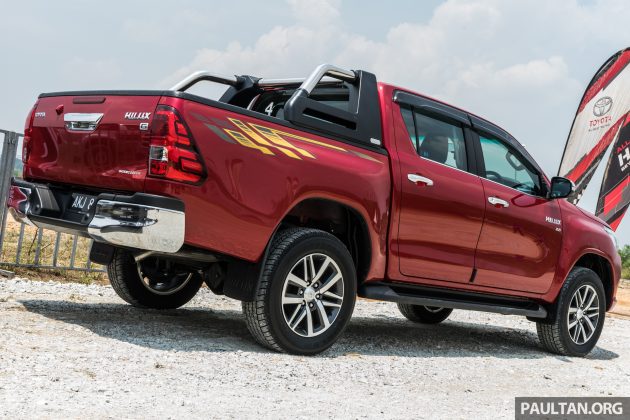



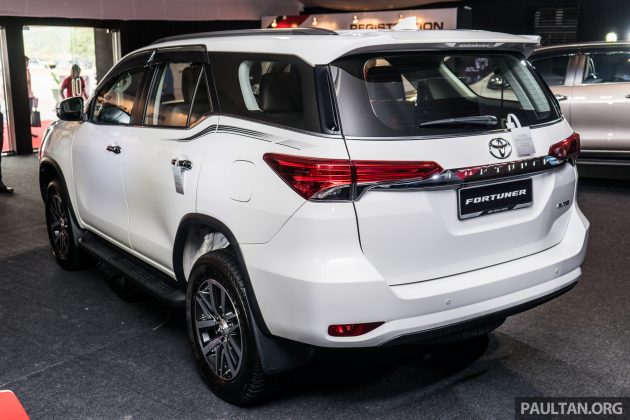



























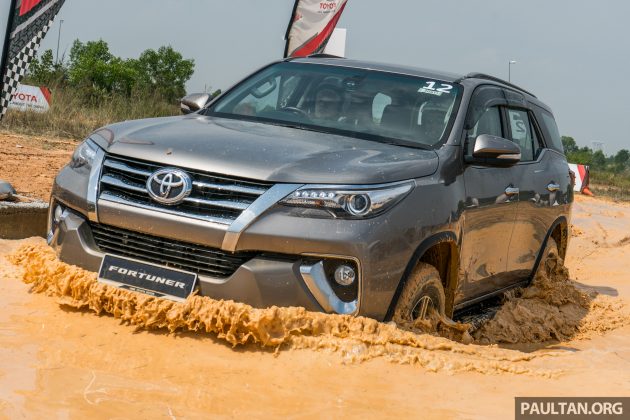
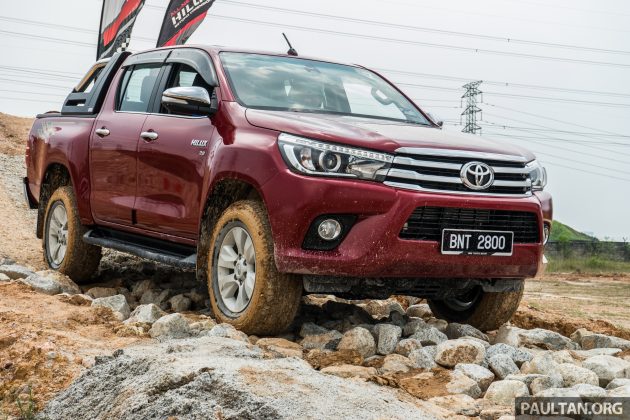

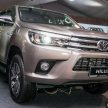
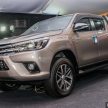
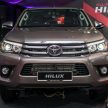
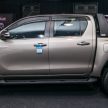
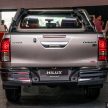
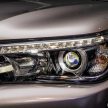

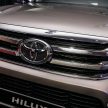
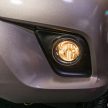
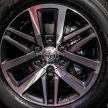
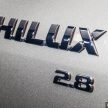
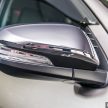
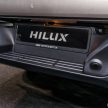
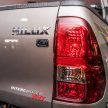
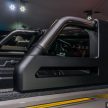
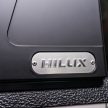
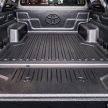

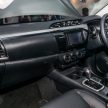
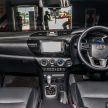
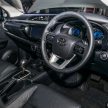
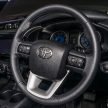
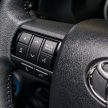



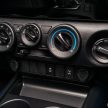
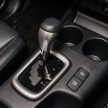
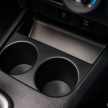

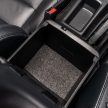
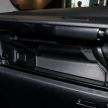

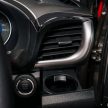
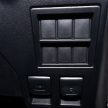
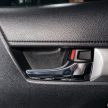

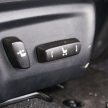
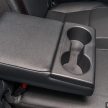
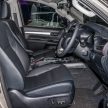

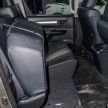
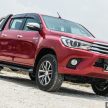
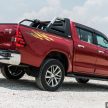

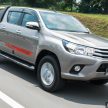
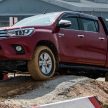
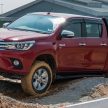
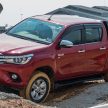
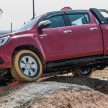

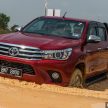
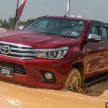
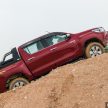
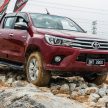
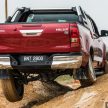
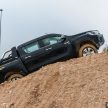
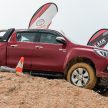
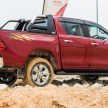
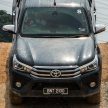
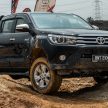
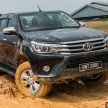
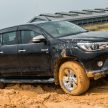
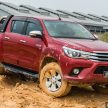
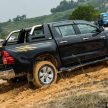
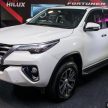
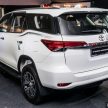
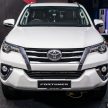
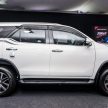
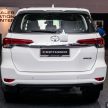

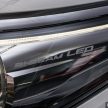
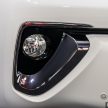
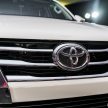
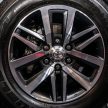
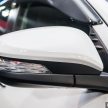
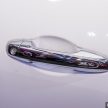
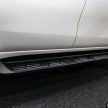
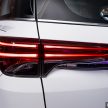
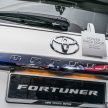
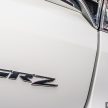
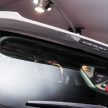

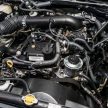
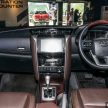
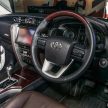
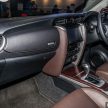
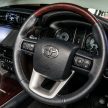
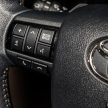

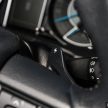
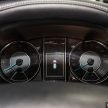
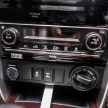
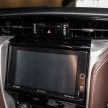

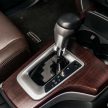
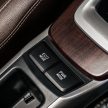
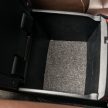
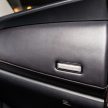

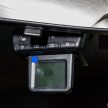
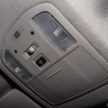
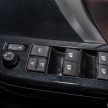
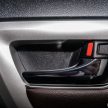

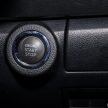
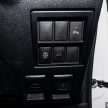
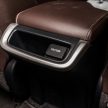
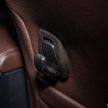
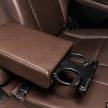
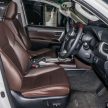
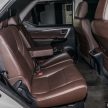
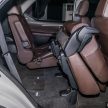

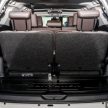
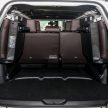
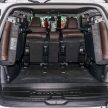
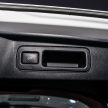
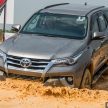





























AI-generated Summary ✨
Comments on the blog post express mixed opinions about the new Toyota Hilux and Fortuner. Many reviewers highlight the Hilux’s poor ride comfort, describing it as jittery and bumpy, unsuitable for family use, and questioning its safety features like VSC. Some criticize the high prices and lack of safety equipment, comparing it unfavorably with competitors like Ford Ranger and Mitsubishi Triton. There are also comments about the vehicles’ CKD/CBU statuses and manufacturing origins, with some questioning the quality standards of ASEAN-made Japanese cars. A few comments praise the vehicle’s reliability, while others express significant dissatisfaction with pricing, safety features, and overall value. Overall, sentiments are largely critical, reflecting disappointment and skepticism about the trucks' quality and pricing strategies.